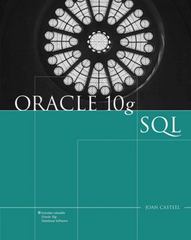Question
Suppose a database has the following three relations. ArtItem (aid: integer, title: string, weightPnd: integer, type: string, pricePaid: integer) ExhibitsIn (artID: integer, exhibitID: integer, insuranceCost:
Suppose a database has the following three relations. ArtItem (aid: integer, title: string, weightPnd: integer, type: string, pricePaid: integer) ExhibitsIn (artID: integer, exhibitID: integer, insuranceCost: integer, deliveryDate: date, homeMuseum: integer) Exhibition (eID: integer, title: string, curatorName: string, specialFee: integer) Visits(exhibitionID: number, lat: string, long: string, startdate: date, enddate: date) Location(latitude: string, longitude: string, name: string, address: string, country: string, phonenumber: string) (The "bit" data type stores 0 or 1. False or true. Booleans.) "lat, long" in Visits are a foreign key referencing "latitude, longitude" in Location. "exhibitionID" in Visits are a foreign key referencing "eID" in Exhibition. "exhibitID" in ExhibitsIn is a foreign key referencing "eid" in Exhibition. "artID" in ExhibitsIn is a foreign key referencing "aid" in ArtItem. The art item weights are measured in pounds.
You may assume simple boolean comparisons (<, >, ) work on dates.
Write the following queries in relational algebra. 1. Find the exhibition titles and exhibition identifiers, and location names, for exhibitions that have been displayed at location in the country "Peru" and at a location in the country "United States".
Step by Step Solution
There are 3 Steps involved in it
Step: 1

Get Instant Access to Expert-Tailored Solutions
See step-by-step solutions with expert insights and AI powered tools for academic success
Step: 2

Step: 3

Ace Your Homework with AI
Get the answers you need in no time with our AI-driven, step-by-step assistance
Get Started


